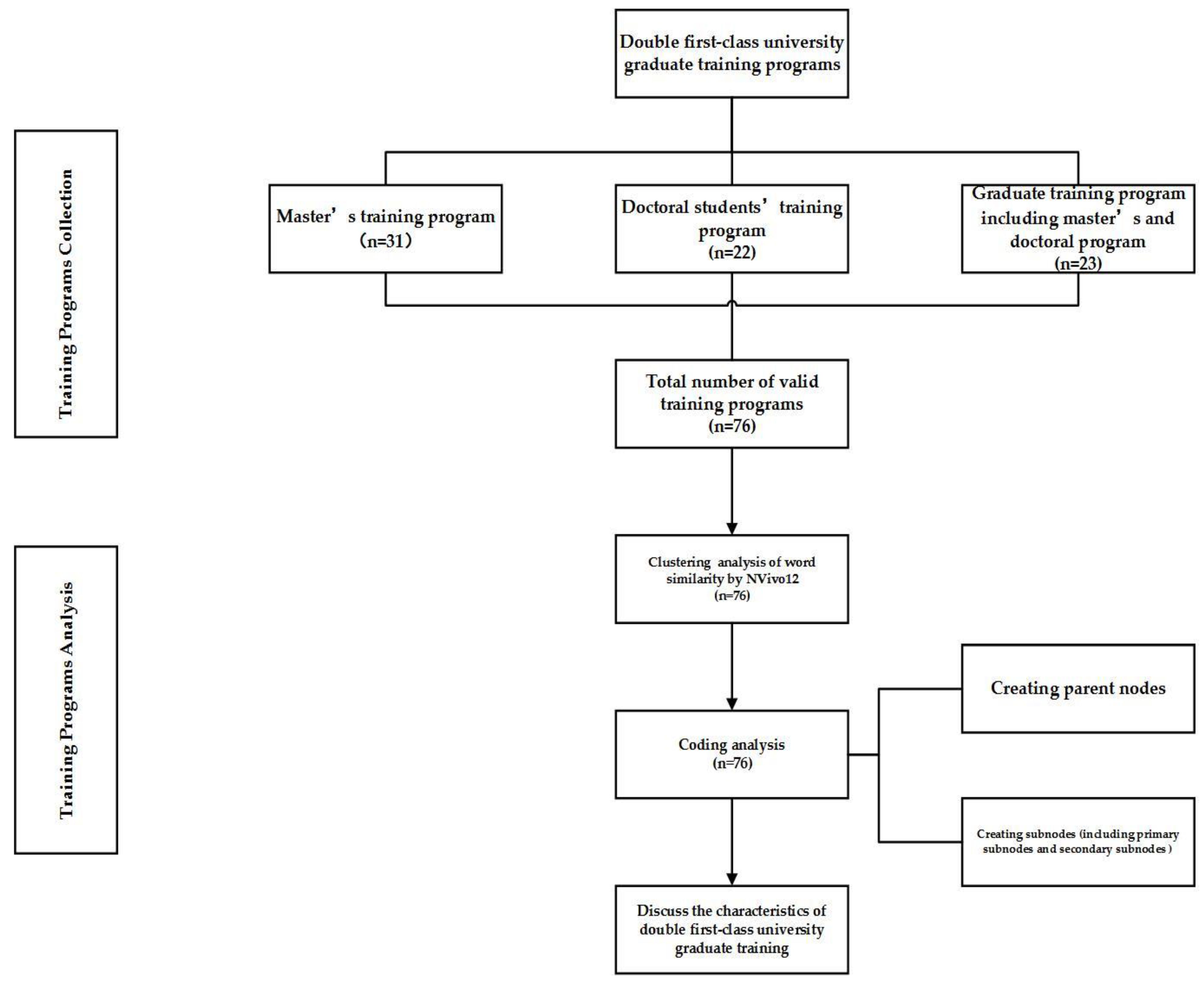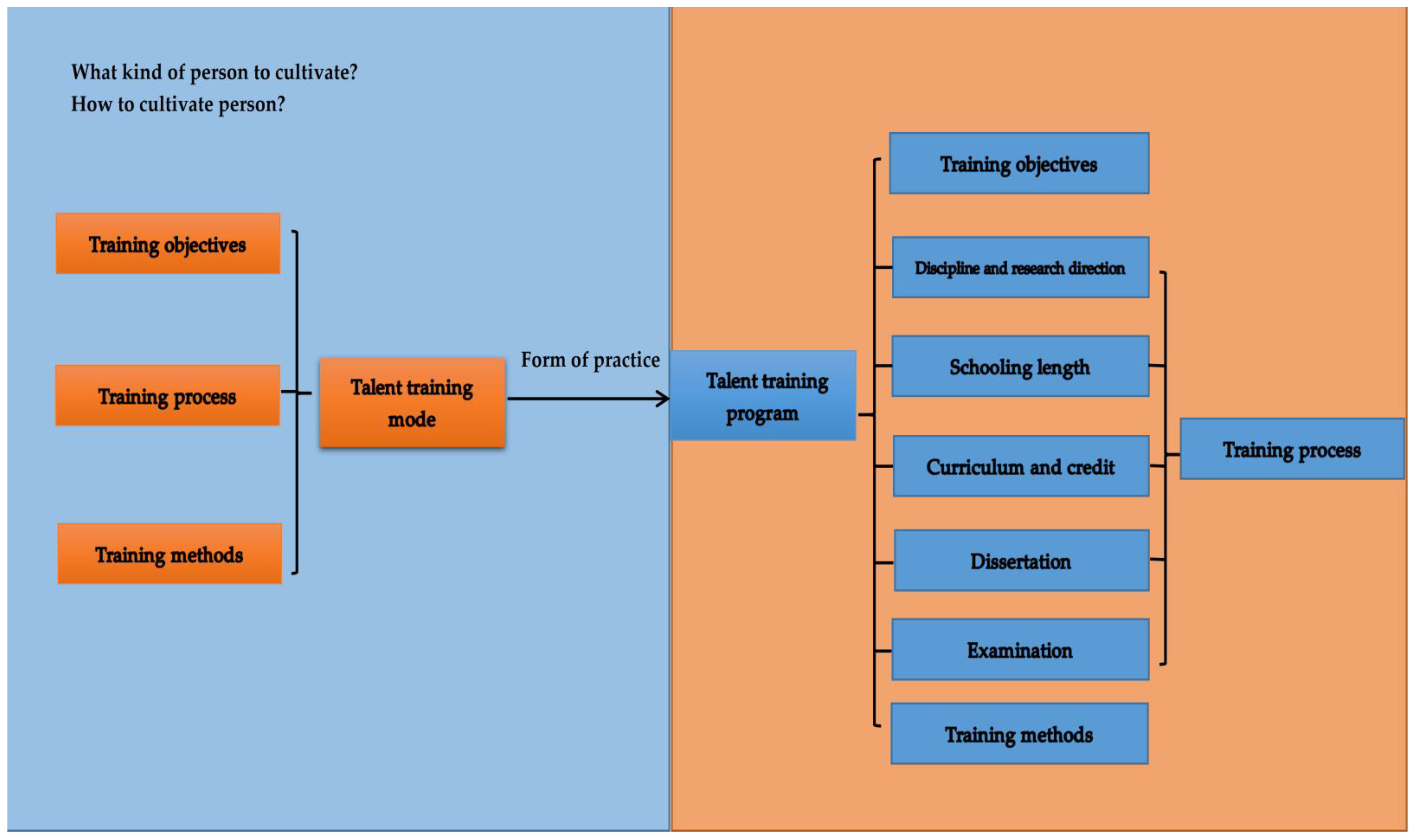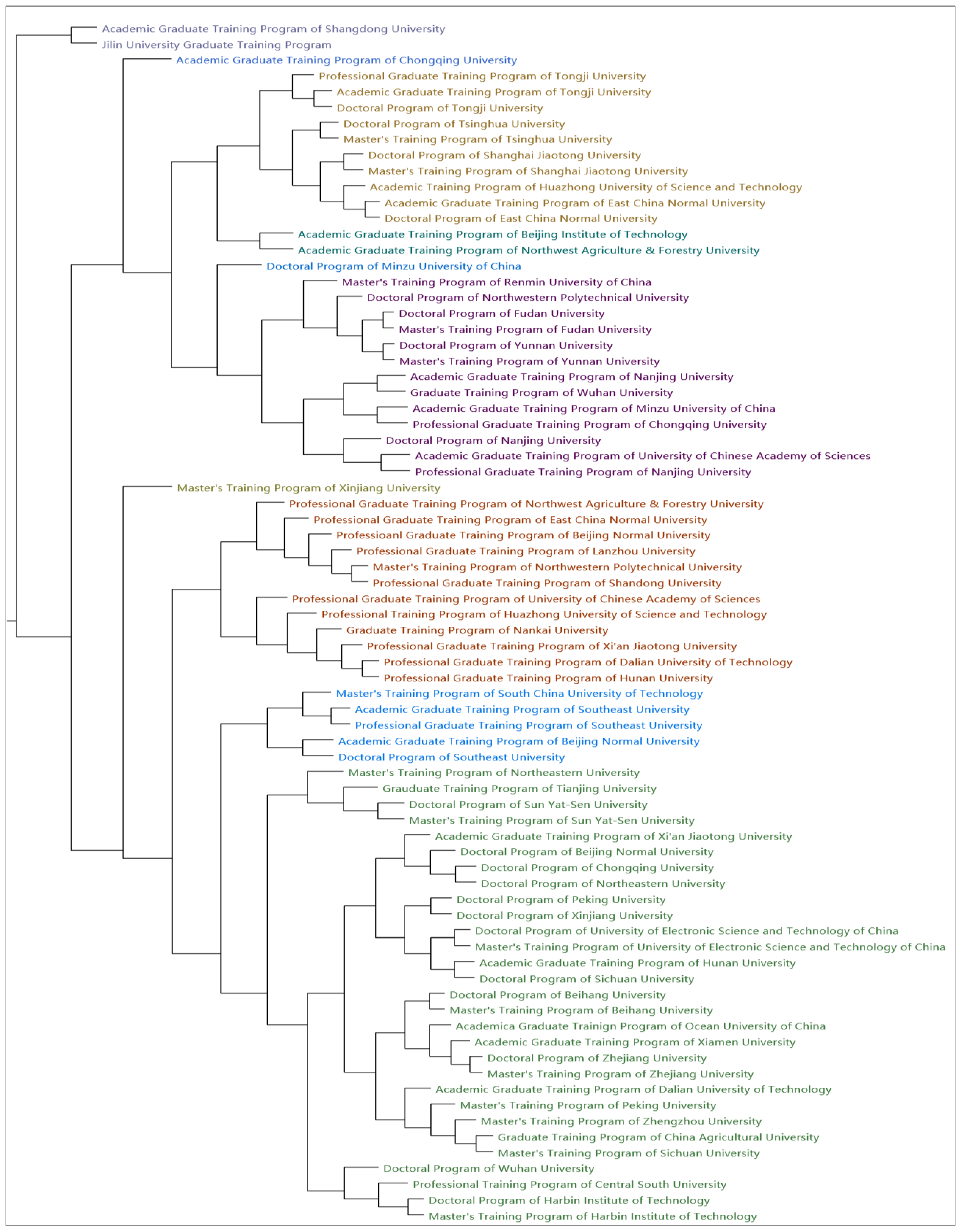How Does Graduate Training Promote Sustainable Development of Higher Education: Evidence from China’s “Double First-Class” Universities’ Programs
Abstract
1. Introduction
2. Literature Review
2.1. Higher Education and Sustainable Development
2.2. The Quality of Graduate Training in Different Countries
2.3. Graduate Training at “Double First-Class” Universities
3. Data and Methods
3.1. Data Collection and Methods
3.2. Conceptual Analytical Framework
4. Results
4.1. Coding Analysis of Training Objectives
4.2. Coding Analysis of Training Process
4.3. Coding Analysis of Training Methods
5. Discussion and Implications
5.1. Training Objectives: Clear Decomposition of Quality and Ability Structure, Pointing to the Students’ Potential for Sustainable Development
5.2. Training Process: Focus on “Training Quality”, Promoting the Connotative Development of Higher Education
5.3. Training Methods: Developing a Mixed Tutorial System to Promote the Students’ Ability for Sustainable Development
6. Conclusions
Author Contributions
Funding
Institutional Review Board Statement
Informed Consent Statement
Data Availability Statement
Acknowledgments
Conflicts of Interest
References
- Chichilnisky, G. What is sustainable development? Land Econ. 1997, 73, 467–491. [Google Scholar] [CrossRef]
- Sachs, J.D. The Age of Sustainable Development; Columbia University Press: Chichester, NY, USA, 2015; p. 1. [Google Scholar]
- Colglazier, W. Sustainable development agenda: 2030. Science 2015, 349, 1048–1050. [Google Scholar] [CrossRef]
- Heleta, S.; Tohiera, B. Sustainable development goals and higher education: Leaving many behind. High. Educ. 2021, 81, 163–177. [Google Scholar] [CrossRef]
- Mamdani, M. Scholars in the Marketplace: The Dilemmas of Neo-Liberal Reform at Makerere University 1989–2005; Imprimerie Saint Paul: Darkar, Senegal, 2007; p. 262. [Google Scholar]
- Weidou, N.; Johansson, T.B. Johansson. Energy for sustainable development in China. Energy Policy 2004, 32, 1225–1229. [Google Scholar] [CrossRef]
- Zhai, T.; Chang, Y.-C. The contribution of China’s civil law to sustainable development: Progress and prospects. Sustainability 2019, 11, 294. [Google Scholar] [CrossRef]
- China Agenda 21; China Environmental Science Press: Beijing, China, 1994; pp. 31–38.
- Ministry of Foreign Affairs of the People’s Republic of China. Progress Report on China’s Implementation of the 2030 Agenda for Sustainable Development. 2021. Available online: http://switzerlandemb.fmprc.gov.cn/web/ziliao_674904/zt_674979/dnzt_674981/qtzt/2030kcxfzyc_686343/zw/ (accessed on 27 September 2021).
- Li, J.; Xue, E. Creating World-Class Universities in China; Springer: Singapore, 2021; p. 2. [Google Scholar]
- Zhao, Y.; He, F.; Feng, Y. Research on the Current Situation of Employment Mobility and Retention Rate Predictions of “Double First-Class” University Graduates Based on the Random Forest and BP Neural Network Models. Sustainability 2022, 14, 8883. [Google Scholar] [CrossRef]
- Fu, H.; Li, M. New trend of Graduate Education under the Background of “Double First-Class” construction. Acad. Degree Grad. Educ. 2018, 1, 75. [Google Scholar]
- Ministry of Education. 2021 National Educational Development Statistical Bulletin. Available online: http://www.moe.gov.cn/jyb_sjzl/sjzl_fztjgb/202209/t20220914_660850.html (accessed on 14 September 2022).
- Nölting, B.; Molitor, H.; Reimann, J.; Skroblin, J.H.; Dembski, N. Transfer for sustainable development at higher education institutions—Untapped potential for education for sustainable development and for societal transformation. Sustainability 2020, 12, 2925. [Google Scholar] [CrossRef]
- Barth, M.; Godemann, J.; Rieckmann, M.; Stoltenberg, U. Developing key competencies for sustainable development in higher education. Int. J. Sustain. High. Educ. 2007, 8, 416–430. [Google Scholar] [CrossRef]
- Nawaz, N.; Durst, S.; Hariharasudan, A.; Shamugia, Z. Knowledge management practices in higher education institutions-a comparative study. Pol. J. Manag. Stud. 2020, 22, 291–308. [Google Scholar] [CrossRef]
- Yuan, X.; Zuo, J. A critical assessment of the Higher Education For Sustainable Development from students’ perspectives—A Chinese study. J. Clean. Prod. 2013, 48, 108–115. [Google Scholar] [CrossRef]
- Wang, J.; Yang, M.; Maresova, P. Sustainable development at higher education in China: A comparative study of students’ perception in public and private universities. Sustainability 2020, 12, 2158. [Google Scholar] [CrossRef]
- Jia, Q.; Wang, Y.; Fengting, L. Establishing transdisciplinary minor programme as a way to embed sustainable development into higher education system: Case by Tongji University, China. Int. J. Sustain. High. Educ. 2019, 20, 157–169. [Google Scholar] [CrossRef]
- Sonetti, G.; Brown, M.; Naboni, E. About the triggering of UN sustainable development goals and regenerative sustainability in higher education. Sustainability 2019, 11, 254. [Google Scholar] [CrossRef]
- Cai, Y.; Ma, J.; Chen, Q. Higher education in innovation ecosystems. Sustainability 2020, 12, 4376. [Google Scholar] [CrossRef]
- Geng, Y. Graduate Education from the Perspective of “Double First-class” construction. Acad. Degree Grad. Educ. 2016, 8, 2. [Google Scholar]
- Xu, Y.; Liu, J.A. Developmental Trends of Graduate Education in China. Int. High. Educ. 2022, 110, 36–37. [Google Scholar]
- Li, J.; Xue, E. Characterizing Graduate Education Development for Creating World-Class Universities: Evidence from Doctoral Education in China. Educ. Philos. Theory 2021, 54, 1–9. [Google Scholar] [CrossRef]
- Wang, C. Field Education: The Demand of Graduate Training. Available online: https://kns.cnki.net/kcms/detail/detail.aspx?dbcode=CCND&dbname=CCNDLAST2022&filename=CSHK202208120040&uniplatform=NZKPT&v=o_ci9wUfGanivEefIqfyB049j8a6qdZrtVYwqWCEWHIo26ltlOdJZ0QrqiR9eTWDZTViyidCqAE%3d (accessed on 12 August 2022).
- Shao, G.; Liu, T.; Wang, Y. Construction of Academic Ecological Environment for Graduate Students based on Tutor Group. J. High. Educ. 2022, 19, 14. [Google Scholar]
- Bai, Q. On First-class Postgraduate Education in First-class Universities. J. Grad. Educ. 2017, 2, 19–24. [Google Scholar]
- Xiao, T.; Dong, Y.; Liu, R. On Constuction of the Second Classroom Curriculum System for Postgraduate from the Perspective of Double First-class Construction. J. Grad. Educ. 2022, 5, 56–61. [Google Scholar]
- Li, J.; Xue, E. Graduate Education Governance in China: A Comprehensive Policy Analysis; Springer Nature: Singapore, 2022; pp. 5–7. [Google Scholar]
- Xu, Y.; Su, F.; Hong, Z. The Mode Exploration of Industry-Education Integration of Graduate Education in China. In Proceedings of the 4th International Seminar on Education Research and Social Science (ISERSS 2021), Kuala Lumpur, Malaysia, 24–26 December 2021; Atlantis Press: Paris, France, 2022; Volume 635, pp. 352–356. [Google Scholar]
- Han, W.; Tian, Y.; Han, Z.; Sun, P.; Jin, X.; Yang, J. Research on the Education System of Practice Base for Professional Master. In Proceedings of the 2022 10th International Conference on Information and Education Technology (ICIET), Matsue, Japan, 9–11 April 2022; pp. 324–329. [Google Scholar]
- Su, Z.; Wang, Y.; Wang, D. Learning Management System in Higher Education: Promoting Hybrid Learning of Postgraduate Taught Students through Optimised Moodle Module Design. J. PGR Pedagog. Pract. 2022, 2, 86–92. [Google Scholar] [CrossRef]
- Charles, S.T.; Karnaze, M.M.; Leslie, F.M. Positive factors related to graduate student mental health. J. Am. Coll. Health 2022, 70, 1858–1866. [Google Scholar] [CrossRef]
- Daniel, B. The Role of Research Methodology in Enhancing Postgraduate Students Research Experience. Electron. J. Bus. Res. Methods 2022, 20, 34–48. [Google Scholar] [CrossRef]
- Liu, F.; Ma, C. Innovation of Postgraduate Training Model in Humanities and Social Sciences Research Institutes of “Double First-class” universities—A Case Study of Wuhan University. J. Soc. Sci. Trends 2021, 12, 99. [Google Scholar]
- Liu, J. Research on Interdisciplinary Postgraduate Training of Literature History and Philosophy under the Background of “Double First-Class”Construction—A Case Study of Xi’dian University. J. Xi’dian Univ. (Soc. Sci. Ed.) 2022, 32, 100. [Google Scholar]
- Gu, W.; Sun, Y.; Ji, D.; Wu, J.; Wu, L. Practicing and Thinking of International Graduate Education by “World-class Universities and Worldclass Disciplines Construction” in Beijing University of Technology. In Proceedings of the International Conference on Management, Education and Social Science (ICMESS 2017), Qingdao, China, 23–25 June 2017; Atlantis Press: Paris, France, 2017; Volume 72, pp. 460–465. [Google Scholar]
- Chen, X.; Li, B. Objectives, Strategies and Guarantees of Graduate Education in Research University in China. Mod. Educ. Manag. 2020, 9, 114. [Google Scholar]
- Luo, H.; Zha, Y. Research on the Construction of Graduate Tutor Team in “Double First-Class” Universities: Taking Central South University as an Example. J. Innov. Entrep. 2022, 13, 30. [Google Scholar]
- Jones, M.; Diment, K. The CAQDA Paradox: A Divergence between Research Method and Analytical Tool. In Proceedings of the 2nd International Workshop on Computer-Aided Qualitative Research, Utrecht, The Netherlands, 4–5 June 2010; Merlien Institute: Maastricht, The Netherlands, 2010; pp. 82–86. [Google Scholar]
- Siccama, C.J.; Penna, S. Enhancing validity of a qualitative dissertation research study by using NVivo. Qual. Res. J. 2008, 8, 92–101. [Google Scholar] [CrossRef]
- Allsop, D.B.; Chelladurai, J.M.; Kimball, E.R.; Marks, L.D.; Hendricks, J.J. Qualitative Methods with NVivo Software: A Practical Guide for Analyzing Qualitative Data. Psych 2022, 4, 142–159. [Google Scholar] [CrossRef]
- Zhou, C.; Zhang, R.; Loginova, J.; Sharma, V.; Zhang, Z.; Qian, Z. Institutional Logic of Carbon Neutrality Policies in China: What Can We Learn? Energies 2022, 15, 4391. [Google Scholar] [CrossRef]
- Dong, M.; Zhou, C.; Zhang, Z. Analyzing the Characteristics of Policies and Political Institutions for the Prevention and Control Governance of the COVID-19 Pandemic: Evidence from China. Int. J. Environ. Res. Public Health 2022, 19, 10980. [Google Scholar] [CrossRef] [PubMed]
- Ministry of Education. A Circular on the Issuance of the Opinions on Deepening Teaching Reform and Training High-Quality Talents to Meet the Needs of the 21st Century. Available online: http://www.moe.gov.cn/srcsite/A08/s7056/199804/t19980410_162625.html (accessed on 10 April 1998).
- Xue, T. Graduate Education; Guangxi University Press: Cuilin, China, 2001; p. 63. [Google Scholar]
- Ran, Y. On the Principles of the Basic Theory of Postgraduate Education in China. J. Grad. Educ. 2020, 2, 10. [Google Scholar]
- Sun, C.; Liu, J.; Razmerita, L.; Xu, Y.; Qi, J. Higher Education to Support Sustainable Development: The Influence of Information Literacy and Online Learning Process on Chinese Postgraduates’ Innovation Performance. Sustainability 2022, 14, 7789. [Google Scholar] [CrossRef]
- Postgraduate Training Program of Harbin Institute of Technology. Available online: http://hitgs.hit.edu.cn/2017/0830/c3358a183544/page.htm (accessed on 30 August 2017).
- Shandong University’s Proposal on Establishing a Training Program for Full-time Professional Master’s Degree Postgraduates (Revised). Available online: http://www.qlyxgrad.sdu.edu.cn/info/1004/1148.htm (accessed on 29 March 2016).
- Regulations on the Training of academic Masters of East China Normal University. Available online: http://www.yjsy.ecnu.edu.cn/_upload/article/files/53/8b/ecf1f0dd446fb2128396d7f57338/3eaa8cbb-534c-4246-b34e-e5363c5a907d.pdf (accessed on 20 September 2020).
- Zhang, D.; Ding, W.; Wang, Y.; Liu, S. Exploring the Role of International Research Collaboration in Building China’s World-Class Universities. Sustainability 2022, 14, 3487. [Google Scholar] [CrossRef]
- Guo, Y.; Wang, X. Chinese Dimension of Postgraduate Education Modernization: Connotation, Characteristics and Trend. J. Grad. Educ. 2019, 6, 21–25. [Google Scholar]
- Degree and Graduate Education Development “13th Five-Year Plan”. Available online: http://www.gov.cn/xinwen/2017–01/20/content_5161660.htm (accessed on 20 January 2017).
- Basic Regulations for the Training of Academic Doctoral Students of Beihang University. Available online: http://graduate.buaa.edu.cn/info/1025/6125.htm (accessed on 15 November 2019).
- Suggestions on Accelerating the Reform and Development of Postgraduate Education in the New Era. Available online: http://www.moe.gov.cn/srcsite/A22/s7065/202009/t20200921_489271.html (accessed on 21 September 2020).






| Coding Categories | Subnodes | Number of Source of Materials | High Frequency Words | Number of Reference Points | Examples of Reference Items |
|---|---|---|---|---|---|
| Knowledge | Theory and special knowledge | 65 | Discipline, major, knowledge | 80 | Shanghai Jiao Tong University: Graduate students should have a solid and broad basic theory and a systematic knowledge of their respective majors. |
| Quality | Quality of ideological and political | 57 | Socialism, compliance with the law, country | 64 | Tongji University: Graduate students should demonstrate the correct direction of politics, love of the socialist motherland, and support for the leadership of the Communist Party of China. |
| Physical and mental health | 29 | Physical health, mental health | 31 | University of Chinese Academy of Sciences: Graduate students should be sound of mind and body. | |
| Ability | Ability of scientific research | 37 | Research, science, scientific research, academic | 50 | Harbin Institute of Technology: Graduate students should have the ability to conduct scientific research independently and creatively; the ability to make creative achievements in scientific research or specialized knowledge; and they should cultivate a rigorous scientific research style, cooperative spirit, and strong communicative ability. |
| Ability to innovate | 38 | Innovation, creativity | 51 | Xi’an Jiaotong University: Graduate students are expected to be top innovators with an international vision. The school aims to improving self-study and innovative practice. | |
| Comprehensive literacy and competence | 30 | Practice, cooperation, organization | 33 | China Agricultural University: Graduate students should possess high literacy, including the ability to do interdisciplinary research, teamwork spirit, cooperative and organizational management. |
| Parent Nodes | Subnodes | Number of Reference Points | Secondary Subnodes | Number of Reference Points |
|---|---|---|---|---|
| Training process | Curriculum setting | 77 | Compulsory course, optional course | 77 |
| Supplementary course | 76 | |||
| Interdisciplinary course | 21 | |||
| Academic and professional course | 17 | |||
| Academic communication | 37 | Academic report and lecture | 43 | |
| Academic conference | 24 | |||
| International communication | 15 | |||
| Dissertation | 82 | Theory, applicability | 29 | |
| Innovation, advancement | 41 | |||
| Independence | 40 | |||
| Practical exercise | 37 | Teaching practice | 45 | |
| Social investigation | 23 | |||
| Professional practice | 65 | |||
| Social investigation | 59 | |||
| Examination | 48 | Curriculum | 3 | |
| Mid-term examination | 21 | |||
| Comprehensive subject Examination (Doctoral qualification) | 31 |
| Parent Nodes | Primary Subnodes | Number of Material Sources | Number of Reference Points | Secondary Subnodes | Number of Reference Points | Examples |
|---|---|---|---|---|---|---|
| Training methods | Tutorial system | 37 | 122 | Individual tutorial system | 132 | Zhejiang University: We implement individual or tutor group guidance, encourage cooperative training at home and abroad, and implement the joint guidance mode of tutor group. |
| Double tutorial system | 142 | |||||
| Tutor group | 424 | |||||
| Curriculum and scientific research | 61 | 86 | Combination of curriculum and scientific research | 9 | Xiamen University: The training of doctoral students focuses mainly on scientific research, while the training of master’s students adopts a combination of curriculum study and dissertation research. | |
| Combination of curriculum and exercise | 1 | |||||
| Combination of curriculum and dissertation | 39 |
Disclaimer/Publisher’s Note: The statements, opinions and data contained in all publications are solely those of the individual author(s) and contributor(s) and not of MDPI and/or the editor(s). MDPI and/or the editor(s) disclaim responsibility for any injury to people or property resulting from any ideas, methods, instructions or products referred to in the content. |
© 2023 by the authors. Licensee MDPI, Basel, Switzerland. This article is an open access article distributed under the terms and conditions of the Creative Commons Attribution (CC BY) license (https://creativecommons.org/licenses/by/4.0/).
Share and Cite
Wang, M.; Zhou, C. How Does Graduate Training Promote Sustainable Development of Higher Education: Evidence from China’s “Double First-Class” Universities’ Programs. Sustainability 2023, 15, 944. https://doi.org/10.3390/su15020944
Wang M, Zhou C. How Does Graduate Training Promote Sustainable Development of Higher Education: Evidence from China’s “Double First-Class” Universities’ Programs. Sustainability. 2023; 15(2):944. https://doi.org/10.3390/su15020944
Chicago/Turabian StyleWang, Man, and Cheng Zhou. 2023. "How Does Graduate Training Promote Sustainable Development of Higher Education: Evidence from China’s “Double First-Class” Universities’ Programs" Sustainability 15, no. 2: 944. https://doi.org/10.3390/su15020944
APA StyleWang, M., & Zhou, C. (2023). How Does Graduate Training Promote Sustainable Development of Higher Education: Evidence from China’s “Double First-Class” Universities’ Programs. Sustainability, 15(2), 944. https://doi.org/10.3390/su15020944






